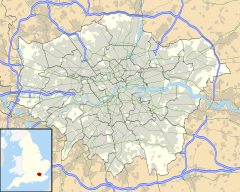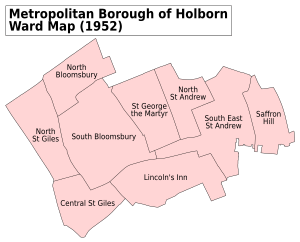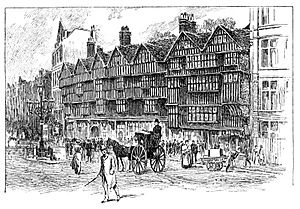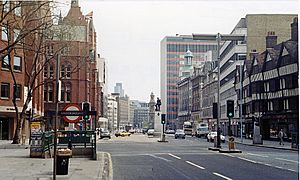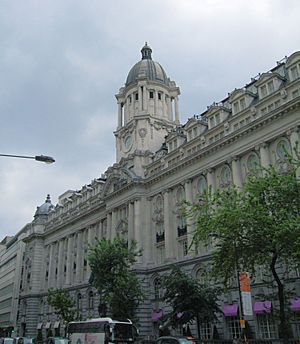Holborn facts for kids
Quick facts for kids Holborn |
|
|---|---|
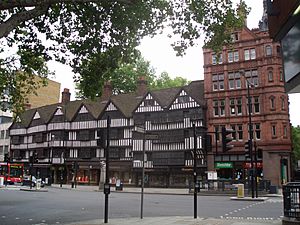 Staple Inn, near Chancery Lane tube station, the last of the Inns of Chancery. |
|
| Population | 13,023 (2011 Census. Holborn and Covent Garden Ward) |
| OS grid reference | TQ310818 |
| London borough | |
| Ceremonial county | Greater London |
| Region | |
| Country | England |
| Sovereign state | United Kingdom |
| Post town | LONDON |
| Postcode district | WC1, WC2 |
| Postcode district | EC1 |
| Dialling code | 020 |
| Police | Metropolitan |
| Fire | London |
| Ambulance | London |
| EU Parliament | London |
| UK Parliament |
|
| London Assembly |
|
Holborn ( HOH-bə(r)n) is a lively area in central London. It covers parts of the London Borough of Camden and a small part of the City of London.
This area is very old, dating back to an ancient parish. It got its name from the River Fleet, which used to flow through a valley here. The river is now buried underground. Holborn is sometimes seen as part of the West End of London.
The main streets, Holborn and High Holborn, follow the path of the old river. They stretch from where the Newgate in the London Wall used to be, all the way towards Westminster.
Holborn is a busy place with many different types of businesses. It's especially known for its strong links to the legal world. You'll also find the diamond trade centre at Hatton Garden and the famous Great Ormond Street Hospital here.
Contents
History of Holborn
What Does "Holborn" Mean?
The name Holborn was first written down in a document from 959 AD. It mentioned an "old wooden church of St Andrew" (St Andrew, Holborn).
The name "Holborn" might come from old English words. "Hol" meant hollow, and bourne meant a brook or stream. This could refer to the River Fleet flowing through a deep valley. Some old maps even called the river "Hole Bourn."
Another idea comes from a historian named John Stow in the 1500s. He thought the name came from the Old Bourne ("old brook"). This was a small stream that he believed flowed into the Fleet River. The exact path of this stream is not clear.
How Holborn Was Governed
Long ago, Holborn was outside the main City of London's control. It was part of Middlesex county. In the 1100s, local papers mentioned "Holburnestrate"—Holborn Street.
The "Bars" were like a boundary for the City of London from 1223. The City's power grew beyond its walls, reaching as far as these Bars. In 1394, a new area called Farringdon Without was created. However, only the south side of Holborn was fully under its rule.
Over time, the way Holborn was governed changed. In 1855, the Holborn District was formed. Later, in 1900, it became the Metropolitan Borough of Holborn. This borough was eventually removed in 1965. Today, most of Holborn is part of the London Borough of Camden.
Important politicians who represent parts of Holborn include Keir Starmer MP, who is the Member of Parliament for Holborn and St Pancras.
How Holborn Grew Over Time
In 1494, King Henry V paid to pave the road because it was so muddy. It was even dangerous for the king's carriages! In the past, criminals from the Tower of London and Newgate Prison were taken through Holborn on their way to be hanged.
In the 1700s, Holborn had many entertainment spots. The Holborn Empire, a music hall, stood here from 1857 to 1960. It was damaged during World War II bombings. This theatre showed the first full-length feature film in 1914, called The World, the Flesh and the Devil.
Famous author Charles Dickens lived in Furnival's Inn in Holborn. He also placed a character from his book Great Expectations, named "Pip", in Barnard's Inn nearby.
Staple Inn is another famous building, known for its old look. These buildings were once "Inns of Chancery," places where law students lived and studied. Two of the main "Inns of Court," Gray's Inn and Lincoln's Inn, are also in Holborn. This shows how important the area has been for the legal profession for hundreds of years.
A plaque at 120 Holborn remembers Thomas Earnshaw. He invented the Marine chronometer, a special clock that helped sailors find their way on long journeys. The old department store Gamages was also here.
Holborn Today
In Ely Place, a gated street, you'll find St Etheldreda's Church. This church was once the private chapel of the Bishop of Ely. For a long time, this street was even considered part of Cambridgeshire county! Today, St Etheldreda's is the oldest church in London used for Roman Catholic worship.
Hatton Garden is the heart of London's diamond trade. It was given to Sir Christopher Hatton by Queen Elizabeth I to give him an income.
Near Holborn Circus is the Church of St Andrew. This old church survived the Great Fire of London. However, it was rebuilt by the famous architect Christopher Wren. Even though parts were destroyed in World War II, it was rebuilt to look like Wren's original design. In the middle of Holborn Circus, there is a large statue of Prince Albert on a horse.
In recent years, Holborn has seen many new offices and hotels built. For example, the beautiful old Pearl Assurance building was turned into a hotel in 1999.
Some people have tried to give Holborn a new nickname, "Midtown." They say this is because it's right in the middle of London, between the West End and the City. However, this name hasn't really caught on with Londoners.
Geography
Nearby Areas
Transport
You can get to Holborn easily by London Underground (the Tube). The closest stations are Chancery Lane and Holborn. The nearest main train station is City Thameslink.
Economy
Holborn is a busy area with many businesses. In recent years, it has become home to new offices and hotels. For example, the old Pearl Assurance building, which has a beautiful classical design, was turned into a hotel in 1999.
Some businesses have tried to call Holborn "Midtown." They say this is because it's located right between the West End (known for shopping and entertainment) and the City (London's financial centre). However, most Londoners don't use this new name.
Notable People
Many interesting people have been connected to Holborn:
- John Barbirolli: A famous conductor.
- Thomas Chatterton: A poet who lived in Holborn.
- Samuel Coleridge-Taylor: A composer known for his "Song of Hiawatha" music.
- Charles Dickens: The famous author lived in Doughty Street, where his house is now a museum.
- Rupert Farley: An actor and voice actor.
- Naomi Lewis: A writer, poet, and animal rights supporter.
- Eric Morley: The person who started the Miss World pageant.
- Ann Radcliffe: A novelist who helped create the "Gothic novel" style.
- Barry Sheene: A World Champion motorcycle racer who grew up here.
- William Morris: An artist and socialist.
- Matthew Ball: A main dancer with the Royal Ballet.
Gallery
-
The headquarters of Sainsbury's at Holborn Circus
-
Entrance to Gray's Inn
-
Royal London Fusiliers Monument on Holborn, remembering those who died in World War I
Images for kids
-
Peter Pan statue at Great Ormond Street Hospital
See also
 In Spanish: Holborn para niños
In Spanish: Holborn para niños


